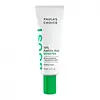What's inside
What's inside
 Key Ingredients
Key Ingredients

 Benefits
Benefits

 Concerns
Concerns

 Ingredients Side-by-side
Ingredients Side-by-side

Water
Skin ConditioningAzelaic Acid
BufferingCetearyl Alcohol
EmollientCeteareth-20
CleansingParaffinum Liquidum
EmollientPropylene Glycol
HumectantPetrolatum
EmollientC12-15 Alkyl Benzoate
AntimicrobialCarthamus Tinctorius Seed Oil
MaskingPolyacrylamide
C13-14 Isoparaffin
EmollientLaureth-7
EmulsifyingGlyceryl Stearate
EmollientPEG-100 Stearate
Isopropyl Alcohol
SolventCarnitine
CleansingBenzyl Alcohol
PerfumingXanthan Gum
EmulsifyingPotassium Sorbate
PreservativeWater, Azelaic Acid, Cetearyl Alcohol, Ceteareth-20, Paraffinum Liquidum, Propylene Glycol, Petrolatum, C12-15 Alkyl Benzoate, Carthamus Tinctorius Seed Oil, Polyacrylamide, C13-14 Isoparaffin, Laureth-7, Glyceryl Stearate, PEG-100 Stearate, Isopropyl Alcohol, Carnitine, Benzyl Alcohol, Xanthan Gum, Potassium Sorbate
Water
Skin ConditioningAzelaic Acid
BufferingC12-15 Alkyl Benzoate
AntimicrobialCaprylic/Capric Triglyceride
MaskingMethyl Glucose Sesquistearate
EmollientGlycerin
HumectantCetearyl Alcohol
EmollientGlyceryl Stearate
EmollientDimethicone
EmollientSalicylic Acid
MaskingAdenosine
Skin ConditioningGlycyrrhiza Glabra Root Extract
BleachingBoerhavia Diffusa Root Extract
Skin ProtectingAllantoin
Skin ConditioningBisabolol
MaskingCyclopentasiloxane
EmollientXanthan Gum
EmulsifyingSclerotium Gum
Emulsion StabilisingPropanediol
SolventButylene Glycol
HumectantPhenoxyethanol
PreservativeWater, Azelaic Acid, C12-15 Alkyl Benzoate, Caprylic/Capric Triglyceride, Methyl Glucose Sesquistearate, Glycerin, Cetearyl Alcohol, Glyceryl Stearate, Dimethicone, Salicylic Acid, Adenosine, Glycyrrhiza Glabra Root Extract, Boerhavia Diffusa Root Extract, Allantoin, Bisabolol, Cyclopentasiloxane, Xanthan Gum, Sclerotium Gum, Propanediol, Butylene Glycol, Phenoxyethanol
 Reviews
Reviews

Ingredients Explained
These ingredients are found in both products.
Ingredients higher up in an ingredient list are typically present in a larger amount.
Azelaic acid is a multitasker ingredient that helps treat acne, pigmentation, and irritation. It is a great option for sensitive skin.
What makes azelaic special?
The best thing about azelaic acid is it's gentleness. It's generally well-tolerated and safe to use alongside other actives like niacinamide or salicylic acid.
Unlike AHAs, azelaic acid will not make you photosensitive/sun sensitive.
You can find this ingredient naturally occurring in grains like wheat, rye, and barley. In cosmetics, azelaic acid is typically lab-made, which is more stable and effective.
Learn more about Azelaic AcidC12-15 Alkyl Benzoate is made up of Benzoic Acid and long chain alcohols. It has a low molecular weight.
C12-15 Alkyl Benzoate is an emollient and texture enhancer. Due to its solubility, it is often used in sunscreens to help evenly distribute active ingredients.
As an emollient, C12-15 Alkyl Benzoate helps soften and hydrate your skin. Emollients create a film on your skin that traps moisture within.
This ingredient has been reported to cause eye irritation.
Learn more about C12-15 Alkyl BenzoateCetearyl alcohol is a mixture of two fatty alcohols: cetyl alcohol and stearyl alcohol. It is mainly used as an emulsifier. Emulsifiers help prevent the separation of oils and products. Due to its composition, it can also be used to thicken a product or help create foam.
Cetearyl alcohol is an emollient. Emollients help soothe and hydrate the skin by trapping moisture.
Studies show Cetearyl alcohol is non-toxic and non-irritating. The FDA allows products labeled "alcohol-free" to have fatty alcohols.
This ingredient is usually derived from plant oils such as palm, vegetable, or coconut oils. There is debate on whether this ingredient will cause acne.
Due to the fatty acid base, this ingredient may not be Malassezia folliculitis safe.
Learn more about Cetearyl AlcoholGlyceryl Stearate is a mix of glycerin and stearic acid.
It is used to stabilize the mixing of water and oil ingredients. By preventing these ingredients from separating, it can help elongate shelf life. It can also help thicken the product's texture.
As an emollient, it helps soften skin and supports barrier-replenishing ingredients.
In cosmetics, Glyceryl Stearate is often made from vegetable oils or synthetically produced.
This ingredient may not be fungal-acne safe
Fun fact: The human body also creates Glyceryl Stearate naturally.
Learn more about Glyceryl StearateWater. It's the most common cosmetic ingredient of all. You'll usually see it at the top of ingredient lists, meaning that it makes up the largest part of the product.
So why is it so popular? Water most often acts as a solvent - this means that it helps dissolve other ingredients into the formulation.
You'll also recognize water as that liquid we all need to stay alive. If you see this, drink a glass of water. Stay hydrated!
Learn more about WaterXanthan gum is used as a stabilizer and thickener within cosmetic products. It helps give products a sticky, thick feeling - preventing them from being too runny.
On the technical side of things, xanthan gum is a polysaccharide - a combination consisting of multiple sugar molecules bonded together.
Xanthan gum is a pretty common and great ingredient. It is a natural, non-toxic, non-irritating ingredient that is also commonly used in food products.
Learn more about Xanthan Gum